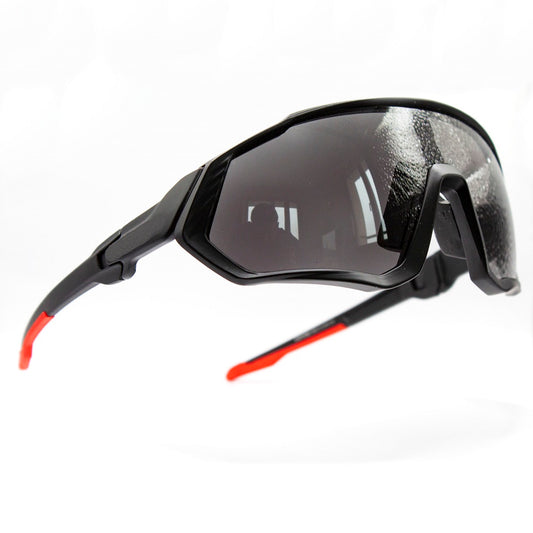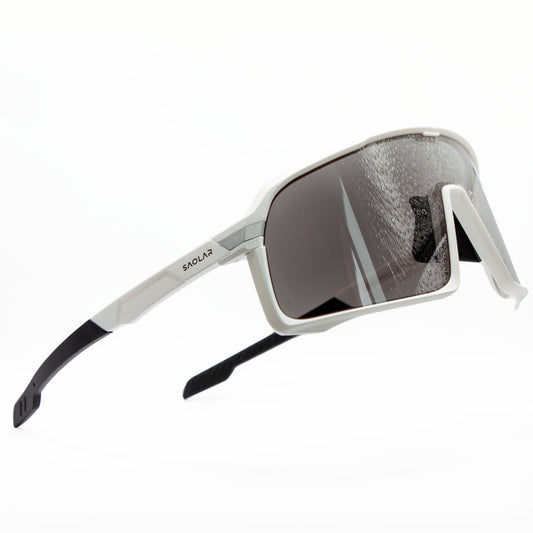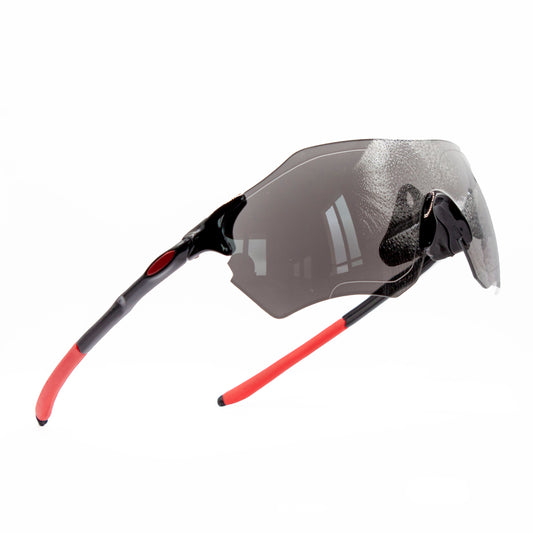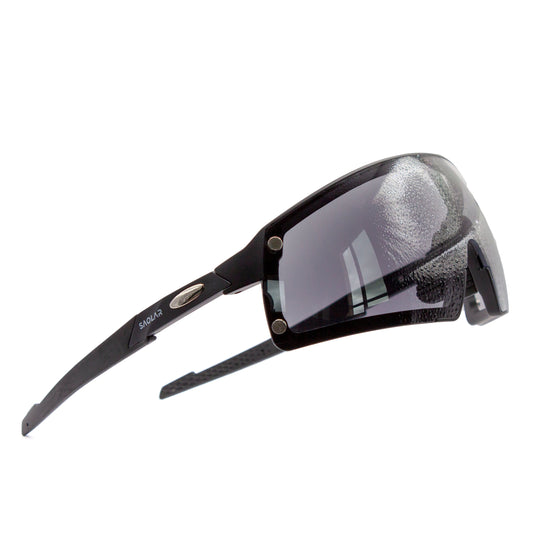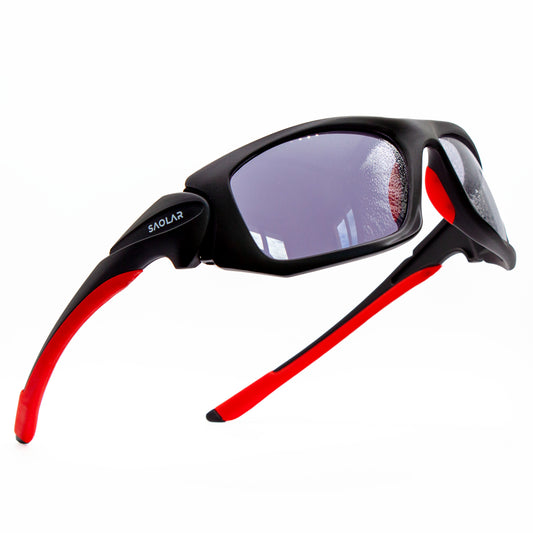The Importance of Eye Protection While Cycling
When cycling, it’s easy to focus on speed, terrain, and endurance, but cycling safety goes beyond just performance. One of the most overlooked risks involves protecting your eyes from cycling debris such as dust, dirt, insects, and small rocks that can be kicked up by the wind or other riders. Without proper eye protection, these hazards can not only cause irritation but also lead to serious accidents by impairing vision in crucial moments.
This is where photochromic glasses come in as an all-in-one solution for cyclists. These high-performance lenses automatically adjust to changing light conditions, ensuring that you don’t need to worry about switching between sunglasses and clear lenses when you’re moving from bright sunlight into shaded areas. The adaptive quality of photochromic cycling glasses provides continuous clarity while still protecting your eyes from debris.
Moreover, photochromic glasses are designed to keep your eyes comfortable and fatigue-free during long rides. By reducing the strain caused by constant light shifts, they help riders stay focused and alert, which is especially important when navigating challenging trails or busy roads. For more details on how photochromic sunglasses can enhance both vision and comfort, check out this article.
Safeguarding your eyes from cycling debris is essential for both performance and safety. Whether you’re an amateur or a seasoned cyclist, investing in photochromic glasses can offer enhanced visibility, improved comfort, and the peace of mind that your eyes are protected, no matter the conditions.
What Are Photochromic Cycling Glasses?
Photochromic cycling glasses are designed to provide optimal vision in varying light conditions by leveraging photochromic technology. These glasses contain special lenses that automatically adjust their tint based on the intensity of sunlight. In bright sunlight, the cycling lenses darken to protect your eyes from harsh glare, while in low-light or cloudy conditions, they remain clear or lightly tinted to maintain visibility. This adaptability makes them ideal for cyclists who frequently transition between different lighting environments, such as riding through shaded forests or open roads.
The secret behind this adaptive sunglasses technology lies in the chemical composition of the lenses. The molecules within the lens react to ultraviolet (UV) light, causing the lenses to darken in bright conditions and lighten when UV exposure decreases. This automatic adjustment ensures that cyclists don’t have to constantly swap between different glasses or struggle with compromised vision in unpredictable lighting.
Besides convenience, photochromic cycling lenses also enhance eye comfort by reducing strain caused by sudden light changes. Constant squinting or exposure to glare can lead to fatigue or even long-term eye damage. By keeping your eyes relaxed and protected, these lenses contribute to both cycling performance and safety.
For more detailed insight into how photochromic sunglasses shield against UV rays and prevent conditions like photokeratitis, check out this informative article.
Photochromic technology provides cyclists with a superior visual experience, allowing for smoother, safer rides without the hassle of manually adjusting to different light levels.
Debris and Cycling: The Hidden Hazards
Cycling is an exhilarating sport, but it comes with its own set of challenges, particularly when it comes to cycling debris. Riders often face hazards like dust, dirt, small stones, and even insects, which can get kicked up by the wind or passing vehicles. These debris elements not only cause discomfort but can pose serious cycling hazards if they impair your vision during crucial moments.
When cyclists ride at high speeds, even a small piece of dirt or debris can fly into their eyes, leading to irritation, blurred vision, or worse, accidents. Eye injuries from cycling debris are more common than many think, making eye debris protection a critical aspect of cycling safety.
This is where photochromic cycling glasses play a crucial role. Not only do they protect against harmful UV rays by adapting to different light levels, but they also act as a robust physical barrier. Their lightweight, durable frames and impact-resistant lenses shield your eyes from dust, debris, and even flying insects. The snug fit of these glasses ensures minimal gaps, providing comprehensive protection against anything the road or trail might throw your way.
For cyclists dealing with conditions like pink eye or sensitivity due to debris exposure, protective eyewear becomes even more essential. In such cases, photochromic glasses help to minimize irritation by shielding the eyes from further debris exposure. To learn more about how sunglasses can protect against eye irritations like pink eye, check out this detailed guide.
In short, photochromic cycling glasses offer superior eye debris protection, helping riders stay safe and focused on the road, free from the dangers of flying debris.
The Benefits of Photochromic Glasses in Preventing Eye Strain
For cyclists, long rides often mean hours of exposure to fluctuating light conditions. Whether riding through sun-drenched stretches or shaded areas, these rapid changes can contribute to eye strain, particularly when constantly squinting or adjusting vision to the environment. This is where photochromic lenses offer significant benefits for eye strain prevention.
Photochromic lenses automatically adapt to the intensity of sunlight, providing seamless transitions between bright and dim lighting. By eliminating the need for manual lens changes or taking off your glasses, these adaptive sunglasses keep your eyes consistently comfortable. This ability to maintain stable vision in diverse conditions significantly reduces eye strain for cyclists, especially during long-distance rides when continuous focus is essential for both safety and performance.
In addition to reducing eye strain, photochromic cycling glasses contribute to overall cycling comfort by lowering the likelihood of headaches caused by excessive glare or squinting. Cyclists prone to headaches or visual fatigue can benefit greatly from these glasses. To dive deeper into how SAOLAR sunglasses prevent headaches while cycling, check out this helpful article.
Ultimately, photochromic lenses not only provide clear vision but also enhance long-term comfort, making them a must-have for cyclists looking to prevent eye fatigue and discomfort during rides of any length.
Why Every Cyclist Needs Photochromic Cycling Glasses
Cycling requires the right gear, and cycling eyewear is essential for both performance and safety. Photochromic cycling glasses offer several advantages, from protecting your eyes from UV rays to shielding them from debris. These protective sunglasses adapt to varying light conditions, ensuring consistent visibility on the road or trail, regardless of changing sunlight.
For cyclists requiring vision correction, many brands, like SAOLAR, provide prescription cycling glasses options. This means you don’t need to sacrifice clear vision for protection. Prescription-ready photochromic lenses allow for both correction and the benefits of adaptive light technology, making them an invaluable tool for riders with specific vision needs.
The safety benefits of photochromic cycling glasses extend beyond just UV protection and visibility. They contribute to better cycling performance by keeping your focus sharp and minimizing distractions like glare and squinting, which can cause eye fatigue over long rides. Investing in these glasses can significantly enhance your comfort and safety. For more insights into how photochromic sunglasses improve rider comfort, explore this article on how photochromic sunglasses keep cyclists' eyes fatigue-free.
Photochromic glasses provide a blend of protection, convenience, and enhanced performance. Whether you’re an amateur or seasoned cyclist, this cycling eyewear is a valuable addition to your gear, allowing for a safer and more comfortable ride in any condition.
FAQ Section
How do photochromic cycling glasses protect against debris?
Answer: Photochromic cycling glasses act as a physical barrier, shielding your eyes from dust, dirt, and other debris that can be kicked up during a ride. Their snug fit ensures minimal exposure, offering robust protection for your eyes.
Are photochromic glasses effective in low-light conditions?
Answer: Yes, photochromic lenses adjust to all light conditions, automatically darkening in bright sunlight and clearing up in low-light environments, ensuring you maintain clarity and eye protection in every situation.
Can I get prescription photochromic cycling glasses?
Answer: Absolutely! Many brands, including SAOLAR, offer prescription cycling glasses with photochromic lenses. These glasses provide clear vision while offering the benefits of adaptive light technology and eye protection.
Do photochromic glasses prevent eye strain during long rides?
Answer: Yes, by adjusting to changing light conditions, photochromic lenses reduce the need for squinting and eye fatigue, making them a valuable tool for eye strain prevention during long-distance rides. Check out more details on preventing eye strain with SAOLAR’s glasses here.
Are photochromic glasses worth the investment for cyclists?
Answer: Definitely! Photochromic cycling glasses provide the perfect blend of adaptability, comfort, and protection from both debris and harmful UV rays. They enhance overall cycling performance and safety, making them a valuable investment for all cyclists.



